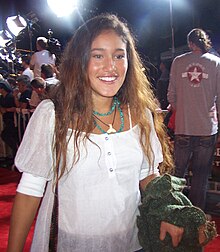Harakmbut
 | |
| Total population | |
|---|---|
| 2000 (2007 census) | |
| Regions with significant populations | |
| Languages | |
| Harakmbut language and Spanish[2] | |
| Religion | |
| traditional tribal religion |
The Harakmbut (Arakmbut, Harakmbet) are indigenous people in Peru. They speak the Harakmbut language. An estimated 2,000 Harakmbut people live in the Madre de Dios Region near the Brazilian border in the Peruvian Amazon.[3]
Amarakaeri[]

Amarakaeri are also called Amaracaire or Amarakaire people. Subgroups of their tribe include the Kochimberi, Küpondirideri, Wíntaperi, Wakitaneri, and Kareneri peoples. As of 1987, 500 Amarakaeri people lived near the Madre de Dios and . Some pan for gold as a means of subsistence.[4]
Huachipaeri[]
Huachipaeri are also known as Huachipaire or Wacipaire people. As of 2000, there were 310 Huachipaeri living near the upper Madre de Dios and . Subgroups of the Huachipaeri including the following, with population figures from 2000:
- Arasairi, population 20
- Manuquiari, population 50
- Puikiri (Puncuri), population 36–50
- Sapiteri, population 12
- Toyeri, population 10[2]
All the subgroups speak dialects of the Huachipaeri language.[2]
History[]
When the Harakmbut were first contacted by members of the Dominican Order in 1940, they numbered 30,000.[3]
Notable Harakmbut people[]
- Q'orianka Kilcher (b. 1990), American actress of Huachipaeri and Quechua descent on her father's side[1]
See also[]
Notes[]
- ^ a b Yuan, Jada. "The Newcover: Q'orianka Kilcher." New York Movies. 18 Dec 2005. Retrieved 15 Feb 2011.
- ^ a b c "Huachipaeri." Ethnologue. Retrieved 15 Feb 2012.
- ^ a b "Peru: Indigenous Harakmbut Suffer Effects Of Climate Change." Indigenous Peoples Issues and Resources. (retrieved 20 Feb 2011)
- ^ "Amarakaeri." Ethnologue. Retrieved 15 Feb 2012.
- Indigenous peoples of the Amazon
- Indigenous peoples in Peru